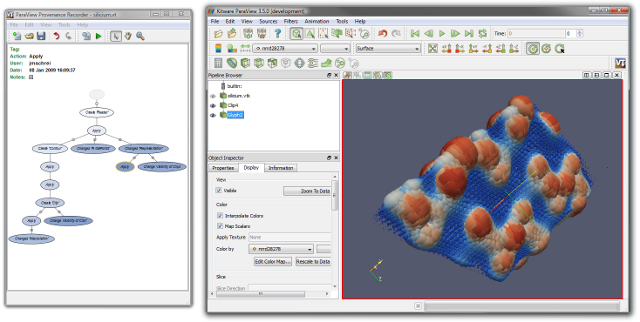Difference between revisions of "ParaView Plugin"
| Line 27: | Line 27: | ||
==== VisTrails ==== | ==== VisTrails ==== | ||
A version of VisTrails that has been adapted to run along side ParaView is located in the 'vistrails' subdirectory of the distribution. [http://www.python.org Python 2.5] | A version of VisTrails that has been adapted to run along side ParaView is located in the 'vistrails' subdirectory of the distribution. [http://www.python.org Python 2.5], [http://trolltech.com/products QT], and [http://www.riverbankcomputing.co.uk/software/pyqt/intro PyQT] are required to run VisTrails. No compiling is necessary, though the 'vistrails' directory must be copied to the ParaView 'plugins' directory so the plugin can find it. The ParaView directory structure may look like this on Windows: | ||
.../paraview.exe | .../paraview.exe | ||
.../plugins/VisTrails.dll | .../plugins/VisTrails.dll | ||
Revision as of 01:27, 9 January 2009
Introduction
The VisTrails plugin for ParaView incorporates the provenance management capabilities of VisTrails into ParaView. All of the actions a user performs while building and modifying a pipeline in ParaView are captured by the plugin. This allows navigation of all of the pipeline versions that have previously been explored.
Please direct questions and bug reports to paraview@vistrails.com.
Download
- The patches for ParaView that are required for the plugin to work are available here under the BSD license.
- The platform independent source code to the VisTrails plugin for ParaView is available for download from SourceForge under the GPL v2
Installation
There are three components to the VisTrails plugin for ParaView. First, a patch to the ParaView source code is required, since ParaView does not provide the necessary access to its undo stack by default. Second, there is a plugin for ParaView that will capture the actions that the user performs. Third, there is a version of VisTrails that has been adapted to interface with the ParaView plugin.
ParaView Patch
Since access to the data structures required by the plugin are not provided by default in ParaView, it must be patched and compiled from source for the VisTrails plugin to work. The source code is not included in the plugin distribution, but can be downloaded from here. Since there has been development on the undo stack in ParaView since the latest official release, there are two patches available inside the VisTrails_ParaView_Patches.tar.gz file:
- ParaView-3.4.0.patch, for the latest release
- ParaView-dev.patch, for the current cvs version
These patches can be applied from within the ParaView source code directory with (use Cygwin on Windows):
patch -p0 < .../VisTrails_ParaView_Patches/ParaView-xxx.patch
The BULID_SHARED_LIBS CMake variable must be set to ON, and ParaView can then be compiled as normal.
Plugin
The source code to the ParaView plugin is located in the 'plugin' subdirectory of the distribution. The plugin, like ParaView itself, uses CMake to generate Visual Studio project files and make files. You may need to set the ParaView_DIR CMake variable to point to your ParaView source directory. The plugin can then be compiled, which creates 'VisTrails.dll' on Windows, and 'libVisTrails.so' on Linux. These can be loaded manually from within ParaView, or it can be copied to the ParaView plugins directory so it automatically gets loaded on startup.
VisTrails
A version of VisTrails that has been adapted to run along side ParaView is located in the 'vistrails' subdirectory of the distribution. Python 2.5, QT, and PyQT are required to run VisTrails. No compiling is necessary, though the 'vistrails' directory must be copied to the ParaView 'plugins' directory so the plugin can find it. The ParaView directory structure may look like this on Windows:
.../paraview.exe .../plugins/VisTrails.dll .../plugins/vistrails/
Usage
With the VisTrails plugin loaded, ParaView may be used as normal. As the user performs actions, they are recorded by VisTrails in the Provenance Recorder window. ParaView pipelines can be loaded simply by clicking on the desired version. Currently, when data files are loaded in ParaView, VisTrails records the absolute filename. Therefore, whenever the pipeline is replayed, all of the data files must be available in the same location.
The user may load ParaView state files, but state loads cannot be undone. When a pipeline that is higher in the version tree is selected, playback must begin at the root, which may be slow. Like data files, the absolute path of state files are stored by VisTrails, so replaying of the state load requires that the file remains in the same place and unchanged.
VisTrails .vt files can be saved and loaded from the Provenance Recorder window, which will include the current state, as well as all previous states that have been explored. State files can also be saved from ParaView, and loaded into instances that do not have the VisTrails plugin loaded.
Most view state changes are not recorded by the plugin. When loading a .vt file, you may need to 'Zoom To Data' for a good view.
Known Issues
- The plugin has only been tested with a local ParaView server configuration.
- When loading ParaView with VisTrails already running, VisTrails captures some of the initialization of ParaView. This is not standard usage, and this has not been seen when the ParaView plugin spawns the VisTrails process itself. However, it is not inconcievable that it could happen. When the Provenance Recorder window opens, it should only have a single empty oval in it. If it has several pipelines already in it, simply create a new VisTrail.
- Only actions that are placed on the undo stack and state loads are captured. Other actions that may be performed that cannot be undone will not be captured, and will not be replayed correctly when navigating the version tree.
